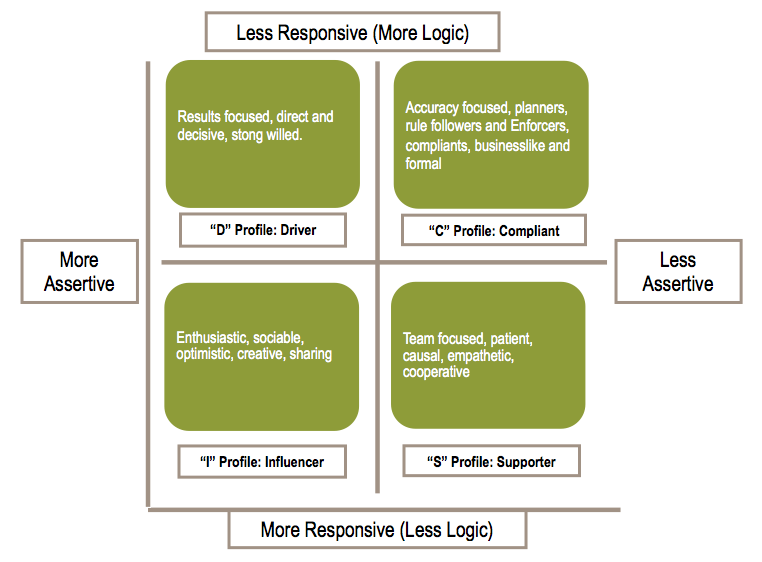The DISC personality-profiling system is one of the easiest to understand and leverage when trying to build web and mobile properties that relate to your users. I’ve written before on the importance of the science of influence and specifically the Self-Determination Theory. Relatedness is one of the three key factors that you need to impact in order to change a consumer’s mind and influence their behavior.
In our Strategy Workshops, we talk about the profiles of your typical users and which profiles they are most likely to have. Without over-complicating it, using the DISC profiling system to determine the primary user type of your prospect and customer base is a great way to think about content and screen optimization. People’s personalities operate in very different ways and while there is no perfect system for communicating with every possible personality type, if we can map your typical user, we can improve our odds of establishing relatedness with your users. Below is the DISC diagram and using a simple 1-10 scale for responsiveness and the same for assertiveness, you can plot out your typical customer’s position on this map.

If there is a specific role that you usually sell to or that your products interact with, you can make some educated guesses about what personality profile they are most likely to be. Some specific examples:
| Role | Personality Style |
| CEO | Driver |
| Marketer | Influencer |
| Engineer | Compliant/Analytical |
| Human Resources | Supportive |
| Sales | Influencer |
| CFO | Compliant/Analytical |
| CTO | Compliant/Analytical |
| Entrepreneur | Influencer |
Considering these different perspectives is a valuable way to ensure that we are designing for the right profiles and producing content in ways that they like to consume. The best chance that you have to relate to these users is to provide subtle adaptions to your content writing and your communications to meet their style.
Some basic examples:
To educate and relate to Drivers:
- Provide concise and useful facts with links to more data (The will not likely read it if they trust you)
- Write summaries of articles that you send them. Do NOT send them un-curated articles to read through
- Do research for them
- Emphasize bottom line
- Ensure they feel that they have control
To educate and relate to Compliant/Analyticals:
- Provide statistics and facts
- Be precise
- Provide information on quality focus
- Provide planning and process documentation
- Provide examples of precision and access to lots of detail
- Do Research for them, but provide them the supporting evidence and links to analyze on their own
To educate and relate to Influencers:
- Use humor
- Tell stories based on experiences
- Weave facts and problem resolutions into stories
- Provide third party stories and case studies
- Provide testimonials with quotes
- Use dynamic language and belief statements
- Be concise
- Use video wherever possible
To educate and relate to Supportives:
- Use stories that emphasize people and how problems are solved
- Provide communication plans and organizational structure documents
- Be warm and friendly, not cold and businesslike
- Use testimonials
- Use video wherever possible with lots of people



